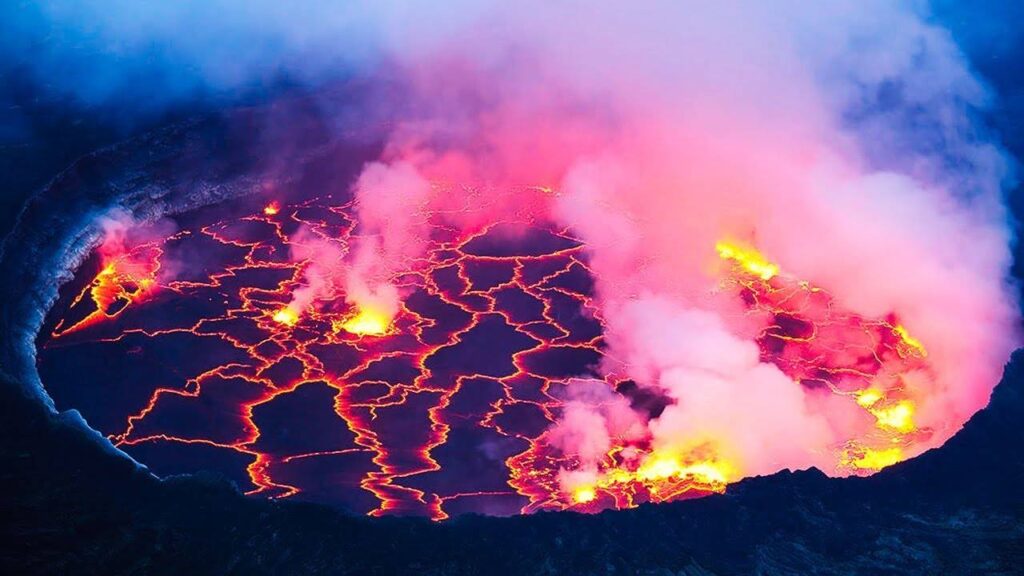5 Facts about Mount Nyiragongo
5 Facts about Mount Nyiragongo: Discover the most fascinating aspects of Mount Nyiragongo, a volcanic mountain in the Democratic Republic of the Congo, with these 5 Facts about Mount Nyiragongo. The oldest and most abundant national park in Africa, Virunga National Park, is home to Mount Nyiragongo. The park is well-known throughout the world because it is home to endangered mountain gorillas, who can be viewed when you go on a gorilla trek in the Congo, where you can observe several Congo gorilla families.

Mount Nyamuragira and Mount Nyiragongo, two active volcanoes in the Virunga mountain range, are the park’s main attractions. Other dormant volcanoes include Mount Mikeno, which is also in Virunga National Park, Mount Sabyinyo, Mount Muhabura, Mount Gahinga, which is shared by Volcanoes National Park and Mgahinga National Park, and Mount Karisimbi and Mount Bisoke in Volcanoes National Park. Mount Nyiragongo is the most fascinating mountain among the others for several reasons and details that are described below;
Here are five fascinating facts about Mount Nyiragongo that may entice you to tackle the mountain. These facts include:
Mount Nyiragongo is a stratovolcano formed by a number of cinder cones, well-aligned volcanic ash, hardened lava, and blocks that are characterized by explosive eruptions that do not pose a threat to property because they harden as soon as they move along the ground. In contrast, Mount Nyiragongo has a low silica level, which makes the lava travel as quickly as possible because the low silica kevels make the magma or lava fluid-like, which causes it to travel more slowly and harden more quickly than lava with a high silica content.
The last documented eruption of Mount Nyiragongo, one of the world’s most active volcanoes, occurred in 2016. The volcano has had 34 recorded eruptions. The active volcano still exhibits eruption-related symptoms, such as the 1977 eruption when the lava lake walls shrank and lava flowed at a speed of 60 km/h. This resulted in the deaths of over 70 people, property damage, and the rise of toxic fumes that have threatened the nearby communities where many people died following the 2016 eruption.

The mountain’s activity: When you visit Virunga National Park and take part in the Mount Nyiragongo walk, you may witness the active volcano at work. You may observe a crater lake with active lava at the top of the mountain. It’s an intriguing fact that this is the world’s largest lava lake. Thus, take part in the Mount Nyiragongo trek to witness the largest and most fascinating lava lake in the world, where lava is boiling and continues to erupt to this day.
2002 eruptions: Despite the mountain’s natural beauty, it has presented numerous dangers to residents of Goma and the surrounding cities of Lake Kivu Gisenyi. The most well-known volcanic eruption that caused numerous tragedies and fatalities was in 2002, when a 13-kilometer hole in the mountain’s southern flank allowed lava to flow into parts of Goma, Gisenyi, and a portion of Gisenyi International Airport via Lake Kivu. This eruption claimed 245 lives. Many people died as a result of the earthquakes that caused buildings to collapse and the massive levels of carbon dioxide that were released into the atmosphere, despite the fact that warnings had been sent and over 400,000 people had been evacuated. After six months of volcanic activity, the mount erupted once more in 2002, although this time it just affected the lava lake that was created.
The 2002 eruptions of Mount Nyiragongo released toxic gases into the atmosphere, which resulted in an increase in deaths, particularly among children. The new vent on the northeastern part of the crater has increased carbon dioxide fumes, which cause a number of diseases and deaths. Additionally, there is fear that the new vent on the eastern edge of the crater will cause an eruption, which is one of the most dreaded natural events for the locals because the last eruption destroyed their property and claimed many lives.
